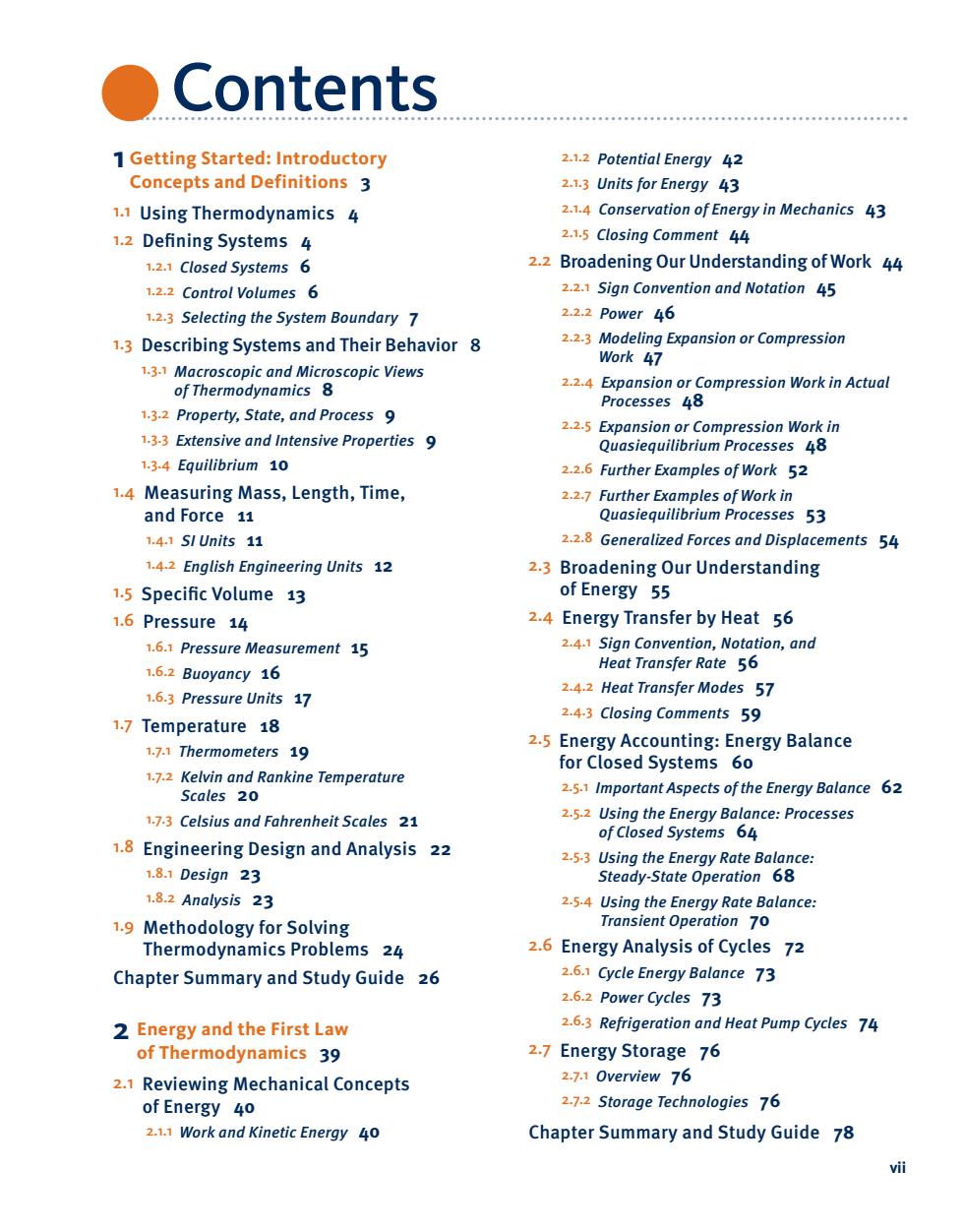正在加载图片...

Contents 中0.0年自g9里中中甲08g中0。年年9g8年g中。0年”。年有4中 Getting Started:Introductory 2.1.2 Potential Energy 42 Concepts and Definitions 3 2.1.3 Units for Energy 43 1.1 Using Thermodynamics 4 2.1.4 Conservation of Energy in Mechanics 43 1.2 Defining Systems 4 2.1.5 Closing Comment 44 1.2.1 Closed Systems 6 2.2 Broadening Our Understanding of Work 44 1.2.2 Control Volumes 6 2.2.1 Sign Convention and Notation 45 1.2.3 Selecting the System Boundary 7 2.2.2 Power 46 1.3 Describing Systems and Their Behavior 8 2.2.3 Modeling Expansion or Compression Work 47 1.3.1 Macroscopic and Microscopic Views of Thermodynamics 8 2.2.4 Expansion or Compression Work in Actual Processes 48 1.3.2 Property,State,and Process 9 2.2.5 Expansion or Compression Work in 1.3-3 Extensive and Intensive Properties 9 Quasiequilibrium Processes 48 1.3.4 Equilibrium 10 2.2.6 Further Examples of Work 52 1.4 Measuring Mass,Length,Time, 2.2.7 Further Examples of Work in and Force 11 Quasiequilibrium Processes 53 1.4.1 SI Units 11 2.2.8 Generalized Forces and Displacements 54 1.4.2 English Engineering Units 12 2.3 Broadening Our Understanding 1.5 Specific Volume 13 of Energy 55 1.6 Pressure 14 2.4 Energy Transfer by Heat 56 1.6.1 Pressure Measurement 15 2.4.1 Sign Convention,Notation,and 1.6.2 Buoyancy 16 Heat Transfer Rate 56 1.6.3 Pressure Units 17 2.4.2 Heat Transfer Modes 57 2.4.3 Closing Comments 59 1.7 Temperature 18 1.7.1 Thermometers 19 2.5 Energy Accounting:Energy Balance for Closed Systems 6o 1.7.2 Kelvin and Rankine Temperature Scales 20 2.5.1 Important Aspects of the Energy Balance 62 1.7.3 Celsius and Fahrenheit Scales 21 2.5.2 Using the Energy Balance:Processes of Closed Systems 64 1.8 Engineering Design and Analysis 22 2.5-3 Using the Energy Rate Balance: 1.8.1 Design 23 Steady-State Operation 68 1.8.2 Analysis 23 2.5.4 Using the Energy Rate Balance: 1.9 Methodology for Solving Transient Operation 70 Thermodynamics Problems 24 2.6 Energy Analysis of Cycles 72 Chapter Summary and Study Guide 26 2.6.1 Cycle Energy Balance 73 2.6.2 Power Cycles 73 2 Energy and the First Law 2.6.3 Refrigeration and Heat Pump Cycles 74 of Thermodynamics 39 2.7 Energy Storage 76 2.1 Reviewing Mechanical Concepts 2.7.1 Overview 76 of Energy 40 2.7.2 Storage Technologies 76 2.1.1 Work and Kinetic Energy 40 Chapter Summary and Study Guide 78 vii1 Getting Started: Introductory Concepts and Definitions 3 1.1 Using Thermodynamics 4 1.2 Defi ning Systems 4 1.2.1 Closed Systems 6 1.2.2 Control Volumes 6 1.2.3 Selecting the System Boundary 7 1.3 Describing Systems and Their Behavior 8 1.3.1 Macroscopic and Microscopic Views of Thermodynamics 8 1.3.2 Property, State, and Process 9 1.3.3 Extensive and Intensive Properties 9 1.3.4 Equilibrium 10 1.4 Measuring Mass, Length, Time, and Force 11 1.4.1 SI Units 11 1.4.2 English Engineering Units 12 1.5 Specifi c Volume 13 1.6 Pressure 14 1.6.1 Pressure Measurement 15 1.6.2 Buoyancy 16 1.6.3 Pressure Units 17 1.7 Temperature 18 1.7.1 Thermometers 19 1.7.2 Kelvin and Rankine Temperature Scales 20 1.7.3 Celsius and Fahrenheit Scales 21 1.8 Engineering Design and Analysis 22 1.8.1 Design 23 1.8.2 Analysis 23 1.9 Methodology for Solving Thermodynamics Problems 24 Chapter Summary and Study Guide 26 2 Energy and the First Law of Thermodynamics 39 2.1 Reviewing Mechanical Concepts of Energy 40 2.1.1 Work and Kinetic Energy 40 2.1.2 Potential Energy 42 2.1.3 Units for Energy 43 2.1.4 Conservation of Energy in Mechanics 43 2.1.5 Closing Comment 44 2.2 Broadening Our Understanding of Work 44 2.2.1 Sign Convention and Notation 45 2.2.2 Power 46 2.2.3 Modeling Expansion or Compression Work 47 2.2.4 Expansion or Compression Work in Actual Processes 48 2.2.5 Expansion or Compression Work in Quasiequilibrium Processes 48 2.2.6 Further Examples of Work 52 2.2.7 Further Examples of Work in Quasiequilibrium Processes 53 2.2.8 Generalized Forces and Displacements 54 2.3 Broadening Our Understanding of Energy 55 2.4 Energy Transfer by Heat 56 2.4.1 Sign Convention, Notation, and Heat Transfer Rate 56 2.4.2 Heat Transfer Modes 57 2.4.3 Closing Comments 59 2.5 Energy Accounting: Energy Balance for Closed Systems 60 2.5.1 Important Aspects of the Energy Balance 62 2.5.2 Using the Energy Balance: Processes of Closed Systems 64 2.5.3 Using the Energy Rate Balance: Steady-State Operation 68 2.5.4 Using the Energy Rate Balance: Transient Operation 70 2.6 Energy Analysis of Cycles 72 2.6.1 Cycle Energy Balance 73 2.6.2 Power Cycles 73 2.6.3 Refrigeration and Heat Pump Cycles 74 2.7 Energy Storage 76 2.7.1 Overview 76 2.7.2 Storage Technologies 76 Chapter Summary and Study Guide 78 vii Contents